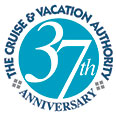Top Cruising Tips - Onboard & On Shore
(Reprinted from Cruise Critic)
Onboard ----------------
Try to catch the sunrise/sunset at least once. We know not everyone's an early riser; if you can't get up for the sunrise, leave time in your schedule to catch a glimpse of at least one sunset. If you're sailing with your sweetheart, embrace the romantic moment. Cruising with family, friends or solo? It's still a great photo opp and a beautiful sight to behold.
Read your daily program, every day. It's your most valuable tool in knowing what's going on onboard the ship. It will alert you to changes in schedules for entertainment and dining venues, announce theme parties and daytime activities, and promote spa specials or one-off events, like ship tours, that you might not otherwise hear about. Bring a highlighter, and mark the activities you're most interested in so they're easy to find. You might also want to bring some paperclips, as you'll probably end up with a lot of papers (daily schedules, cocktail invites, daily puzzles, etc.) you want to keep together. Some lines -- like Norwegian -- are even unveiling free apps with the same information to make it easier to stay informed.
Start out organized. As soon as you get to your cabin, unpack everything, putting thought into where your belongings should go. Your things might not stay in their designated place, but for a few days you won't be hunting around searching for your other bikini or pair of sneakers.
Invite new friends to join you at specialty restaurants. Unless you're going for that romantic table for two, it's often more fun to bring a group to an alternative dining venue. More people make it easier to try different bottles of wine or dishes (like when you can't decide among all the desserts), and the conversation is livelier. Some venues -- like Celebrity's Qsine and Norwegian's Teppanyaki -- particularly lend themselves to communal meals.
Nap on sea days. Guilt-free. Who cares if you're missing the lecture on Mayan civilization, the cha-cha class or afternoon tea? It's your vacation, and you can relax however you want.
Don't let seasickness ruin your vacation. It's easy to find ways to minimize its effects. If you're prone to nausea, spend your time near the middle of the ship, on lower decks. Onboard shops sell seasickness remedies; the prices are high, but you can generally snag some for free at guest services. For more natural options, try eating ginger candy or green apples.
Before you do anything else, tour the ship. It's not that big, and if you familiarize yourself with the areas where you're most likely to be spending time, as well as the closest elevators and stairwells to your cabin, you'll spend less of your precious vacation wandering around lost.
Don't default to the lido buffet at lunch. On sea days, cruise ship alternative restaurants are often open for lunch. They're typically not as busy as they are in the evenings -- and usually the surcharge is discounted. Keep an eye out for one-off barbecues and brunches, as well, for more interesting midday meals.
Don't come onboard hungry. Hold off on lunch and, instead, explore the ship while everyone else heads straight to the buffet or main dining room. You might stumble across a lesser-known, much less crowded dining option. And, if not, you can hit up the buffet when the crowds die down.
On Shore---------------------
Avoid the morning rush. Wait until the crowds have dispersed, and get off at your leisure. You'll avoid lines and touts. Come back before the big rush, too.
Bring a drawstring backpack. They're convenient for carrying everything from sunscreen and towels to wallets and room keys. Plus, if you buy any souvenirs, you have a place to stow them until you get back on your ship. They're also less bulky than regular backpacks and more secure than purses.
Balance your days ashore. If you don't want to return home needing a vacation from your vacation, change up the pace of your days ashore, especially on a port-intensive cruise. Maybe one day is an intense history and culture sightseeing expedition, another is a beach outing, and a third is simply about hanging out at a cafe and watching the world pass by. We're even fans of (occasionally) staying onboard while a ship's in port. It feels like you've got the whole vessel to yourself.
Be realistic about your limitations when you do an excursion. Vacation is all about letting go and trying new things, but you're not magically going to be able to do something you weren't capable of doing at home. If you can't bike comfortably for a few hours, skip the cycling tour; if you're afraid of heights, a zip-line outing in Jamaica isn't going to cure you. Use your head, and be safe.
Read shore tour descriptions with a critical eye. The shore tour brochure is marketing material, aimed at making an excursion sound very attractive and separating you from your money. Therefore, you often need to read between the lines to determine if the tour is for you. (What's not said is as important as what's written.) A tour that visits multiple attractions in a few hours might have you spending more time on a bus than exploring each location. A hike marked as strenuous may mean different things on a mainstream line with a younger crowd than it does on a luxury line with older clientele. When in doubt, ask the shore excursions desk about the actual breakdown of activities on a tour that interests you.
Sub schlocky souvenirs for local buys. Let's be realistic: T-shirts, shot glasses and magnets are only going to collect dust when you bring them back home. Plus, they were likely made in China, rather than the port you're actually visiting. Instead, put your money toward an authentic meal or a craft made by a local artist. Supermarkets are great for "foodie" souvenirs. Things like olive oils (in cans, rather than heavy bottles), dried herbs, chocolates, jams and specialty flours travel well and last a long time so you can relive your trip for months to come -- without breaking the bank.
Do your research in advance. Don't wait until you're onboard to figure out your plan for port days. You'll get the most out of your time ashore if you do your homework to learn what each port is known for and what you might want to do there (take a tour, walk around, explore on your own, etc.). Consult your travel consultant who can provide port profiles and destination-focused information. The more prepared you are, the less time you'll waste wondering what to do when you get there.
Get the lay of the land. On the advance planning theme, if you familiarize yourself with a port's layout before you arrive, you can ditch a fair amount of taxis and tours. Look up directions to major attractions to determine if they're within walking distance of the ship or easily accessed on public transit. This is especially useful in smaller ports, where many of the sights are close to the ship. Taking the occasional self-guided walking tour or riding the bus can save money and also make for an adventure. Just be aware of any areas considered unsafe for tourists, and travel in a group for additional safety.
Skip ship-sponsored excursions in favor of DIY tours. While private excursions and guides can be more expensive than big-group bus tours, it might be worth more to have a trip tailored to your personal interests without needless "filler stops" at touristy souvenir shops or restaurants. Check with your travel consultant to get ideas and recommendations. Or just venture into port under your own power, and go it alone. This provides a feeling of independence, but it does require more planning and research up front. However, for destinations that are notoriously difficult to access from the port, it's often easier to go with the ship-sponsored tours.

With each issue of Ultimate Experiences Online, you’ll enjoy a collection of articles, slideshows and videos that we will inspire you to make your travel dreams a reality.

To help you discover ways to explore the world, we're pleased to share our The Travel Magazine Online.
 Save money and escape the crowds. Hot Deals and multi-port packages. Savings of up to 50%!
Save money and escape the crowds. Hot Deals and multi-port packages. Savings of up to 50%!

Our free app that allows you to carry all of the destination information you need while traveling, right in your pocket!

We recommend optional travel insurance that protects you in the event of having to cancel your trip avoiding travel vendor cancellation policies and more!





